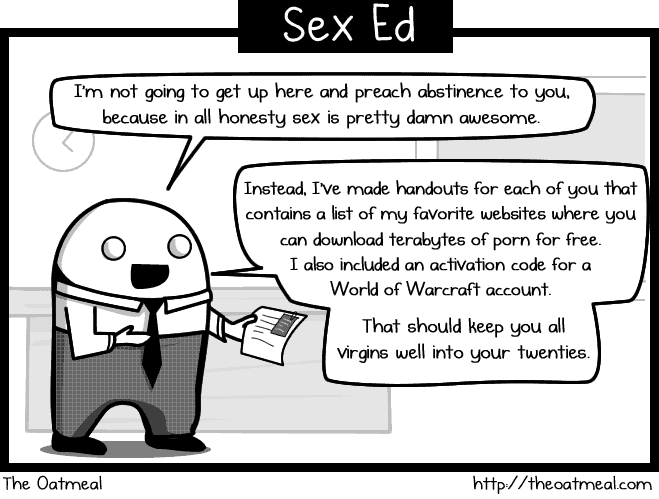
Or more specifically, let’s talk about how we talk to students about sex. I don’t know about you, but my school’s version of “sex education” was to give us an anatomy lesson on the female and male genitalia during year 9. Naturally this resulted in the whole class giggling for an hour about the drawing of a penis in front of them. Additionally, the information about contraception was fairly limited to learning how to roll a condom onto a “penis” (read: banana). Again, lots of giggles and not much was learnt. Our “sexual” education was conception education. This doesn’t surprise me given the uncomfortable situation PE teachers were in, having to deliver life lessons about the birds and bees to their high school students.
People don’t like the idea of talking to teenagers about sex so discussing sex education is slightly taboo. “The talk”, traditionally given by parents to their children, is widely viewed as an incredibly awkward experience. People worry that if adolescents learn about sex, they’re more likely to do it. Firstly this has been found by many studies to be incorrect and secondly this creates a fear of sex, which is ridiculous. Sex is one of our most primal urges, one that is essential for the survival of our species. Instead of acknowledging this, we have a culture that condemns sexual behaviour, chastising those to openly talk about it.
First of all, let’s get to know a bit more about what we’re talking about. Sex education programs refer to school-based, formal education about sex, often delivered to high school students. They started to be developed in the 1970’s when the rates of STIs and unwanted pregnancies became more public knowledge. As the HIV/AIDS epidemic emerged in the 1980’s and it was discovered to be sexually transmitted, sexual health was put under the spotlight. As such, most schools now include some form of sexual education.
There are numerous philosophies of sexual education, with content varying between the philosophies and individual programs. Common focuses are contraception – for both STI and pregnancy prevention, conception, menses and puberty. Other focuses such as non-heterosexual sex and sexualities, social issues surrounding sex and pleasure are frequently omitted.

Overall, involvement in any sex education program is related to lower sexual risk-taking behaviours (e.g. increased use of condoms). However sex-positive education has, as demonstrated by a literature review released in 1993, been correlated with better sexual health statistics, such as lower rates of STIs, than abstinence based sex education.
Preventing unwanted pregnancies is particularly important with girls being more highly educated, having career ambitions and therefore wanting to delay having children. Given that it is increasingly rare for people to have children while they are still in school, it is difficult to measure whether the programs are successful. Studies are limited due to the length of time they can be conducted, as follow-up becomes almost impossible once the students graduate. Moreover the largest compounding factor is socioeconomic strata, where higher rates of unwanted pregnancies, along with dropout rates, are seen both with and without sex education.
To determine the effectiveness of sex ed programs, age of first intercourse is often considered. To be honest I don’t really give a crap. This idea that the age at which people lose their virginity holds some immeasurable significance is wrapped up in antiquated ideas about the importance of virginity and chastity. I think what is more important is whether people feel positive about their sexual experiences and know the implications of having sex. But just because I’m sure you’re all wondering, no statistically significant difference has been found in the age of defloration in those who have participated in abstinence-based programs compared to sex positive programs.
Additionally, given that people are having intercourse at younger ages, it is particularly pertinent that sex education is delivered at younger ages. This is the same conclusion reached by a systematic review of 10 studies of varying sex ed programs. Students that are educated adopt safe sex practices; therefore they should be educated before they have sex so they can adopt these practices from the beginning.
Another very important aspect of sex, separate from simply avoiding pregnancy and STIs, is how people feel about sex – feeling safe, not just being safe. Sex education can impact how people feel about sex. It can shape how people view themselves as they sexually mature and also how they view others as they enter the ages when sexual relationships become the norm. Indeed a randomised control trial run in Scotland, released in 2002, showed that a more comprehensive sexual education program reduced the feelings of regret associated with first sexual intercourse. Feelings pertaining to sex, not just sexuality, can be the source of much agony for teens, so any chance to reduce this should be readily implemented.
Slightly more contentious, is the idea of teaching students about the role of pleasure in sex and sexual development. Culturally, it is usually considered inappropriate to talk to children about sexual pleasure and different forms of sex. However doing just this can be a powerful tool to enable people to feel more positive about their sexual experiences. Entering sexual maturity comes with new experiences, questions and an exploration of what sex means to the individual. When, if not in high school, is the time to address this? High school years are the most formative and vulnerable ones, where a sense of identity is being developed. A 2005 study looking at programs that do and don’t discuss sexual pleasure concluded that teaching about sexual pleasure has the potential to improve public sexual health outcomes. Moreover the authors suggested that people knowing and understanding the role of sexual pleasure can enable people to feel more comfortable in themselves and make them less likely to pressure others, and be pressured, into a sexual relationship. 
I want to very briefly touch on abstinence-based programs. There are two main subtypes within this: abstinence-only which does not provide information on contraception, and more broad abstinence programs which can also include information on contraception, however still only endorse abstinence. The outcomes of these broader programs are better than no sexual education or abstinence-only, but are not as good as sex-positive programs.
Moreover a 2006 paper entitled “Abstinence and abstinence-only education: a review of U.S. policies and programs” came to the interesting conclusion that “abstinence-only programs threaten fundamental human rights to health, information and life.” It also stresses that although true abstinence does prevent unwanted pregnancies and STIs, presenting it as the only option is an inappropriate message to deliver to students. This leaves students in a vulnerable position, as they often do not know about contraception and prevention of STIs.
Unfortunately, despite this recognition, from 1995 to 2002, formal sex education became more abstinence based, with only 62% of females and 54% of males receiving education on birth control methods before becoming sexually active.
Many of you may now be thinking “OK, I get it, sex ed can be improved, but how is this a feminist issue?” Well firstly the burden of pregnancy (obviously) unduly affects women. Additionally, by sex ed programs exploring the importance of an equal partnership (which most do not) – being respectful of your partner, mutual pleasure, mutual consent – women can feel more comfortable in their relationships. Educating men on the nature of consent and equal partnership can potentially help to curb domestic violence and rape rates. This is not to imply that men are always the abusers and women are always the victims, indeed it can be the reverse and abuse also occurs in same sex couples, however statistically, men are more likely to be the perpetrators of rape and domestic abuse.
Ample research has shown the connection between gender norms and power disparities, and sexual attitudes and practices. A 2005 paper entitled “Sex Education: Sexuality, Society and Learning” identified discussions on gender to be a gap in the curriculum and concludes that current sexual education is “relatively disconnected from the social context in which sex takes place.” Sex and gender roles are so intricately entwined that talking about one without the other is almost impossible. By facilitating an exploration of these in a safe environment, the social culture surrounding sex can begin to be understood and shaped by those who are in it.
Moreover, everyone on the gender spectrum has the right to feel sexually comfortable. This can be greatly improved by sex ed. Educating people on the different types of sexual relationships can allow them to be viewed as more acceptable, as shown in a review published in 1993. This can enable people who engage in non-heteronormative P-in-V type sex to not feel as isolated and ostracized as many currently do. Indeed, a 2001 study noted that a common observation in sexual education classes is the homophobia of both students and teachers that is not formally addressed.
Education is required for, and about, those that do not fit into the sexual mould. Enormous complexities exist within the spectrum of sexuality, with an added dimension of different sexual practices. To address this successfully can give many marginalized people the power to accept who they are and be accepted by others. If we can teach our youth that sex and sexuality are fluid ideas, that relationships should be consensual with equal respect and power given to both (or all) people, then we have a real shot at having a more accepting generation.
Sexual education is about more than just sex. It’s about more than condoms on bananas and what pubic hair is. It has the potential to make a more sexually accepting youth. This does not mean encouraging youth to have sex, but encouraging them to accept people who do have sex, how they have sex and what it means to have sex. Preventing STIs and unwanted pregnancies are worthwhile and necessary aims, however for sex ed programs to truly be successful, they need to address sex and sexuality with all the social complexities included.
